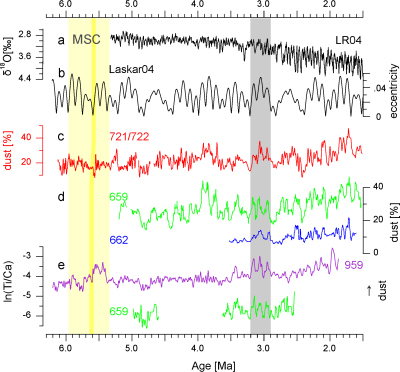- Home
- About us
- People
- Alumni
- Former Personnel
- Miocene-Pliocene Records
Miocene-Pliocene Records
Hybrid insolation forcing of Pliocene monsoon dynamics in West Africa
Kuechler RR, Dupont LM, Schefuß E
Climate of the Past 14 (2018) 73-84
doi.org/10.5194/cp-14-73-2018
Pliocene environmental change in West Africa and the onset of strong NE trade winds (ODP Sites 659 and 658)
Vallé F, Dupont LM, Leroy SAG, Schefuß E, Wefer G
Palaeogeography, Palaeoclimatology, Palaeoecology 414 (2014) 403-414
doi:10.1016/j.palaeo.2014.09.023
Humid conditions prevailed between 3.24 and 3.20 Ma (salmon pink bar in the figure below). Strengthening of the NE trade winds was concurrent with increased supply of plant wax (n-alkanes) to the North Atlantic during the intensification of the Northern Hemisphere Glaciations (blue bars) around 2.7, 2.6, and just before 2.5 Ma.
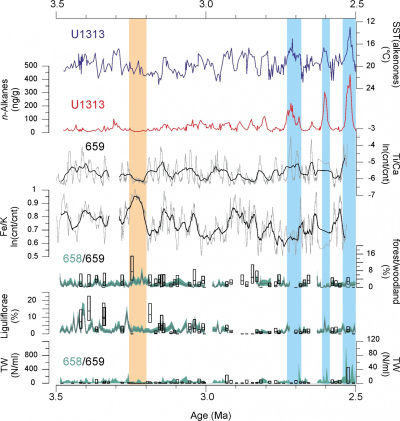
Marine palynology of the ODP Site 658 (N-W Africa) and its contribution to the stratigraphy of Late Pliocene
Leroy S, Dupont L
Geobios 30 (1997) 351-359
doi:10.1016/S0016-6995(97)80194-5
Development of vegetation and continental aridity in northwestern Africa during the Late Pliocene: the pollen record of ODP Site 658
Leroy S, Dupont L
Palaeogeography, Palaeoclimatology, Palaeoecology 109 (1994) 295-316
doi:10.1016/0031-0182(94)90181-3
Steps toward drier climatic conditions in north-western Africa during the Upper Pliocene
Dupont LM, Leroy SAG
In: Vrba E, Partridge T, Denton D, Burckle L (eds)
Palaeoclimate and evolution, with emphasis on human origins
Yale University Press, New Haven (1995) 289-298
Equatorial West Africa
Orbital‑driven environmental changes recorded at ODP Site 959 (eastern equatorial Atlantic) from the Late Miocene to the Early Pleistocene
Vallé F, Westerhold T, Dupont LM
International Journal Earth Sciences 106 (2017) 1161–1174
doi:10.1007/s00531-016-1350-z
Fig. 6 (Vallé et al. 2017) Pliocene dust records
a. LR04 global oxygen isotope stratigraphy (Lisiecki and Raymo 2005).
b. Eccentricity (black) after Laskar et al. (2004).
c. Estimate of dust over the Arabian Sea after magnetic susceptibility from ODP Sites 721/722 (deMenocal 1995), in red 11 pt moving average.
d. Dust over the tropical East Atlantic from Site 659 (green) after Tiedemann et al. (1994) and equatorial east Atlantic from Site 662 (blue) after Ruddiman and Janecek (1989), 11 pt moving averages, age model of Site 662 after Lisiecki and Raymo (2005) and (Herbert et al. 2010).
e. Ti/Ca ratios after XRF scanning of the equatorial East Atlantic Site 959 (lila, Vallé et al. 2017) and Site 659 (green, Vallé et al. 2014), 31 pt moving averages.
Grey shading denotes a period with high eccentricity overlapping the mid-Pliocene Warm Period (2.9–3.2 Ma).
Light yellow shading denotes the Messinian Salinity Crisis (MSC, 5.97–5.33 Ma, Manzi et al. 2013) and dark yellow shading the period 5.60–5.55 Ma (when the connection between Atlantic and Mediterranean was severed). For the period from 5.7 to 5.4 Ma, our age model deviates by 0.05 Ma from the established Mediterranean chronology.
NB: time scale runs from left (old) to right (young)
Namibia
Linking desert evolution and coastal upwelling: Pliocene climate change in Namibia
Dupont LM, Donner B, Vidal L, Pérez EM, Wefer G
Geology 33 (2005) 461-464
doi:10.1130/G21401.1
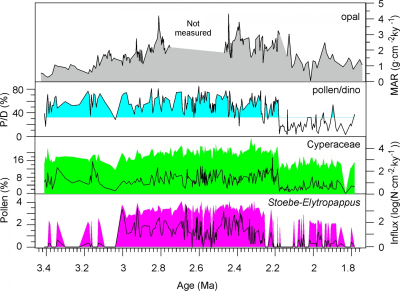
Figure 3 of Dupont et al. 2005.
opal. Opal mass accumulation rates (MAR), calculated by opal weight percentage from Pérez et al. (2001, ODP Scientific Results 175) multiplied by the dry bulk density from Wefer et al. (1998, ODP initial Reports 175) and the sedimentation rates showing the Matuyama Diatom Maximum in the Namibian (Benguela) Upwelling System.
pollen/dino. Total pollen expressed as percentage of total pollen and dinoflagellate cysts indicating the shift toward decreased terrestrial input in the marine sediments at 2.2 Ma.
Cyperaceae. Percentage of total pollen (line, left scale) and pollen accummulation rates (shading, right scale) of Cyperaceae (sedges). The drop in the record of sedges indicates that mainly riverine input decreased suggesting aridification in Namibia.
Stoebe-Elytropappus. Percentage of total pollen (line, left scale) and pollen accummulation rates (shading, right scale) of Stoebe-Elytropappus type as an indicator of the extension of the Cape flora and increased northward trade wind transport.
NB: time scale runs from left (old) to right(young)
Late Pliocene vegetation and climate in Namibia (southern Africa) derived from palynology of ODP Site 1082
Lydie Dupont
Geochemistry, Geophysics, Geosystems 7 (2006) Q05007
doi:10.1029/2005GC001208
Late Pliocene climate change documented in seismic and palynology data at the southwestern African margin
Weigelt E, Dupont L, Uenzelmann-Neben G
Global and Planetary Change 63 (2008) 31-39
doi:10.1016/j.gloplacha.2008.05.001
Steps in the intensification of Benguela upwelling over the Walvis Ridge during Miocene and Pliocene
Hoetzel S, Dupont LM, Marret F, Jung G, Wefer G
International Journal of Earth Sciences 106 (2017) 171-183
doi:10.1007/s00531-016-1309-0
Miocene–Pliocene vegetation change in south-western Africa (ODP Site 1081, offshore Namibia)
Hoetzel S, Dupont LM, Wefer G
Palaeogeography, Palaeoclimatology, Palaeoecology 423 (2015) 102-108
doi:10.1016/j.palaeo.2015.02.002
see also 'Floral change > Miocene'
The role of fire in Miocene to Pliocene C4 grassland and ecosystem evolution
Hötzel S, Dupont LM, Schefuß E, Rommerskirchen F, Wefer G
Nature Geoscience 6 (2013) 1027-1030
doi:10.1038/NGEO1984
South Africa
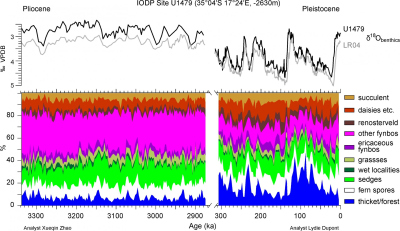
IODP Site U1479 has been retrieved SW of Cape Town and collected pollen from the vegetation of the western and southern Cape. The modern vegetation consists of renosterveld and different types of fynbos. Along the coast thicket is growing and in the Cape Mountains patches of Podocarpaceae forest can be found. The Pliocene part of the pollen record shows dominance of fynbos and renosterveld vegetation. Fluctuations are rather subdued but follow a precession rhythm. This is probably an effect of the latitudinal temperature gradient during austral winter shifting the balance between the winter rainfall regime of the western Cape and the year-round rainfall zone of the southern Cape. The Pleistocene part of the pollen record shows much more variability. Additional to the effects of the latitudinal temperature gradient, the continental shelf emerged during the later glacial periods when sea-level was low opening up large areas for vegetation to grow and animals to roam. The Pliocene part of the record is published in Zhao et al. (2020), a paper about the Pleistocene part is in preparation.
Hydroclimate change in subtropical South Africa during the mid-Piacenzian Warm Period
Zhao X, Koutsodendris A, Caley T, Dupont L
Quaternary Science Reviews 249 (2020) 106643
doi:10.1016/j.quascirev.2020.106643
Climate-driven rampant speciation of the Cape flora
Dupont LM, Linder HP, Rommerskirchen F, Schefuß E
Journal of Biogeography 38 (2011) 1059-1068
doi:10.1111/j.1365-2699.2011.02476.x
see also 'Floral change > Miocene'
Miocene to Pliocene development of surface and sub-surface temperatures in the Benguela Current System
Rommerskirchen F, Condon T. Mollenhauer G, Dupont L, Schefuß E
Paleoceanography 26 (2012) PA3216
doi:10.1029/2010PA002074
Miocene to Pliocene changes in South African hydrology and vegetation in relation to the expansion of C4 plants
Dupont LM, Rommerskirchen F, Mollenhauer G, Schefuß E
EPSL 375 (2013) 408-417
doi:10.1016/j.epsl.2013.06.005
Tropical elements such as Petalidium decline to very low values after 7 Ma. Deuterium increases to less depleted values between 8 and 7 Ma indicating more aridity in western southern Africa. The decrease to more depleted deuterium values between 7 and 5 Ma is probably due to a shift of the precipitation source from the Atlantic to the Indian Ocean as a result of stronger coast parallel winds, more upwelling and colder sea surface temperatures blocking the penetration of humidity from the Atlantic into the continent. After 5 Ma the winter rain vegetation starts to develop in the Western Cape as indicated by pollen percentages of Stoebe/Elytropappus, probably because of increasing importance of the westerlies for the precipitation of the Western Cape.
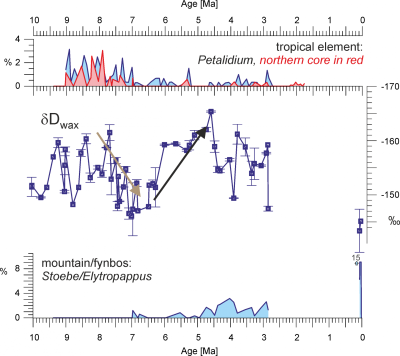
South America
We used sediments from the Carnegie Ridge offshore of Ecuador to study vegetation change in the western part of tropical South America during the final closure of the Central American Seaway (4.7 - 4.2 Ma) and the final Pliocene (3.6 - 2.6 Ma) including the mid-Piacenzian warm period. The period covers the time in which the East Pacific cold tongue developed and ENSO gradually changed into its Pleistocene mode.
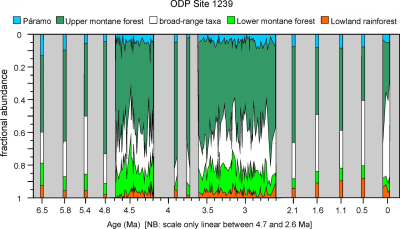
Piacenzian environmental change and the onset of cool and dry conditions in tropical South America
Grimmer F, Dupont L, Jung G, Wefer G
Paleoceanography and Paleoclimatology 35 (2020) e2020PA004060
doi:10.1029/2020PA004060
Early Pliocene vegetation and hydrology changes in western equatorial South America
Grimmer F, Dupont L, Lamy F, Jung G, González C, Wefer G
Climate of the Past 14 (2018) 1739-1754
doi:10.5194/cp-14-1739-2018



